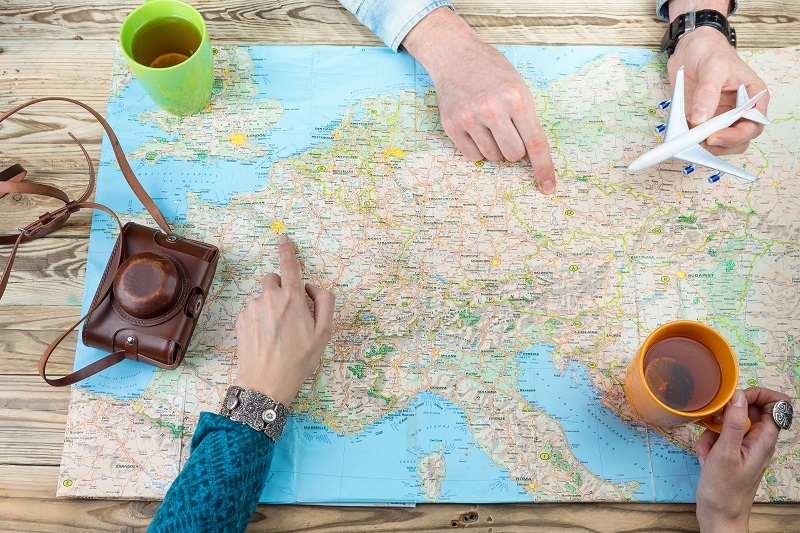
Traveling to other countries and connecting with diverse spiritual communities provides a unique perspective on the world's array of spiritualities. However, it is helpful to have a grasp of interfaith travel etiquette so your visit is meaningful, enjoyable, and respectful. Understanding and practicing etiquette means avoiding misunderstandings and mistakes, while helping travelers foster deeper engagement with local communities. In this guide, we’ll cover practical tips on respecting religious customs abroad, what to wear at holy sites, and navigating interfaith travel do’s and don’ts to become an ethical visitor anywhere in the world.
When scheduling visits to temples, churches, mosques, synagogues, or other places of worship, being aware of interfaith travel etiquette is key to a mindful journey. When visiting, guests should familiarize themselves with local customs and practices, learn what is appropriate and what is not, and approach the culture with reverence. Simple gestures like removing shoes, or wearing modest clothing, or not taking photos in restricted areas are all signals of gratitude, and can enhance your experience.
In addition to following practices related to the site, being aware of the community's values, customs, sacred items, and daily practices demonstrates that the visitor is genuinely interested. This is an example of ethical behavior as a visitor and helps ensure your experience is a positive one.
Being aware that, for example, respecting religious practice while travelling is an important aspect of interfaith travel manners. All religions have their practices, and sometimes small unintentional mistakes can be offensive. For example:
Each of these practices may be a sign that the traveller is aware and respectful. Ignoring them may take away from an enriching experience.
What to wear in sacred places is probably the most asked question by travelers. Dressing respectably shows you respect the occupants' beliefs and culture. Here are some general guidelines:
Knowing what to wear at sacred places is a central aspect of interfaith travel etiquette, so one can expect to be greeted and treated with respect.
Appropriately traveling among various faith communities does require some interfaith travel do’s and don’ts:
Following these simple guidelines will allow for an enjoyable visit and show that you are truly interested in the spiritual environment of the community.
Traveling to diverse spiritual communities is not just a tourist endeavor—it's an experience of cultural immersion. Although the Buddhist temples of Thailand and the ancient churches of Europe are certainly amazing sights, it is an enriching experience to uncover the values and practices of each respective community.
When entering new religious and cultural spaces:
Being respectful to community members shows that you care for the burden of ethical travel, and your presence is seen as more than annoying; it is more welcome.

Acting like an ethical visitor in a new space is more than just following guidelines—it is about awareness and compassion. Follow these guidelines for ethical travel behavior:
Being a responsible traveler means you contribute positively (socially and environmentally) to the place you visit, and it represents you well as an interfaith traveler.
Even experienced travelers may face difficulties in visiting a variety of sacred places. Issues may relate to language, the unfamiliarity of customs or home country, or conflicting social or cultural norms. To address this:
By anticipating the difficult, complex contexts alongside observable respect, you are following proper interfaith travel etiquette, while still enhancing your overall experience.
Families and groups have unique challenges when it comes to visiting sacred sites. Important tips include:
Group travel is a good way to experience and learn together about the different ways to respect religious traditions while also modeling pro-social behavior for younger travelers.
Technology can also contribute to misconceptions about etiquette in today's travel experience. Exercise caution and refrain from posting images or videos of local people on social media without their prior consent. Privacy is a priority; do not post pictures or videos that may misrepresent or commodify sacred ceremonies, etc. The principles outlined here are regarded as professional etiquette of interfaith travel and ethical tourism; in other words, digital travel behaviors and engagement reflect one's respect in the physical world.
There is more to visiting sacred spaces and places of faith than interest. It requires awareness, planning, and respect. By applying interfaith travel protocols and learning how to appropriately dress when engaging with sacred spaces and places, behave ethically as travelers, and know the interfaith travel “do's” and “don'ts,” one may have respectful experiences of the faith and practice of people around the world. A traveler may take interfaith travel etiquette into practice to travel and engage in an enriching experience by building relationships while being respectful of the faith and practices of the local community.
Engaging thoughtfully, respectfully, and sensitively with different faith communities allows the travelers to leave with a positive and ongoing experience from every trip and pilgrimage.
This content was created by AI